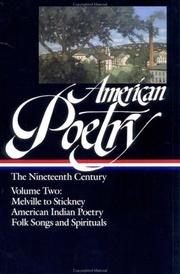| Listing 1 - 10 of 17 | << page >> |
Sort by
|
Book
ISBN: 1526131269 1526131242 9781526131249 Year: 2020 Publisher: Manchester (England)
Abstract | Keywords | Export | Availability | Bookmark
 Loading...
Loading...Choose an application
- Reference Manager
- EndNote
- RefWorks (Direct export to RefWorks)
This book tells the history of the London black music culture that emerged in post-colonial London at the end of the twentieth century; the people who made it, the racial and spatial politics of its development and change, and the part it played in founding London's precious, embattled multiculture. It conceives of the linked scenes around black music in London, from ska, reggae and soul in the 1970s, to rare groove and rave in the 1980s and jungle and its offshoots in the 1990s, to dubstep and grime of the 2000s, as demonstrating enough common features to be thought of as one musical culture, an Afro-diasporic continuum. Core to this idea is that this dance culture has been ignored in history and cultural theory and that it should be thought of as a powerful and internationally significant form of popular art.
Music --- Black people --- Social aspects --- History --- History and criticism. --- Black music. --- Clubs. --- DJ. --- Dance. --- London. --- Multiculture. --- Music. --- Paul Gilroy. --- Space. --- Warehouse Party.
Book
ISBN: 9789400604728 9400604726 9789087284329 Year: 2024 Publisher: Amsterdam Amsterdam University Press
Abstract | Keywords | Export | Availability | Bookmark
 Loading...
Loading...Choose an application
- Reference Manager
- EndNote
- RefWorks (Direct export to RefWorks)
Since before the American Civil War, African American and Japanese encounters produced relationships and discourses of knowledge that transcended Eurocentric conceptions of civilization and hierarchies of personhood. Black Transnationalism and Japan introduces the diverse activity and intellectual movements created, shaped, and led by Japanese and African American people. While some Pan-Asianisms and Pan-Africanisms urged a uniting of colonized spaces against the colonizer, and were often expressed in the form of decolonization movements, this volume introduces various transnational phenomena that transcended such dichotomies. Black American-Japanese transnational encounters often occurred on the non-state level from within the two new competing empires of America and Japan. Such transnational encounters reveal not only heretofore hidden historical actors, friendships, and solidarities, but also innovative cultural productions that challenged hierarchies of race, culture, and imperialism.
Book
ISBN: 9400604726 Year: 2024 Publisher: Amsterdam : Amsterdam University Press,
Abstract | Keywords | Export | Availability | Bookmark
 Loading...
Loading...Choose an application
- Reference Manager
- EndNote
- RefWorks (Direct export to RefWorks)
Since before the American Civil War, African American and Japanese encounters produced relationships and discourses of knowledge that transcended Eurocentric conceptions of civilization and hierarchies of personhood. Black Transnationalism and Japan introduces the diverse activity and intellectual movements created, shaped, and led by Japanese and African American people. While some Pan-Asianisms and Pan-Africanisms urged a uniting of colonized spaces against the colonizer, and were often expressed in the form of decolonization movements, this volume introduces various transnational phenomena that transcended such dichotomies. Black American-Japanese transnational encounters often occurred on the non-state level from within the two new competing empires of America and Japan. Such transnational encounters reveal not only heretofore hidden historical actors, friendships, and solidarities, but also innovative cultural productions that challenged hierarchies of race, culture, and imperialism.
Book
ISBN: 0520954688 9780520954687 9780520275232 0520275233 Year: 2013 Publisher: Berkeley
Abstract | Keywords | Export | Availability | Bookmark
 Loading...
Loading...Choose an application
- Reference Manager
- EndNote
- RefWorks (Direct export to RefWorks)
Charles Mingus is among jazz's greatest composers and perhaps its most talented bass player. He was blunt and outspoken about the place of jazz in music history and American culture, about which performers were the real thing (or not), and much more. These in-depth interviews, conducted several years before Mingus died, capture the composer's spirit and voice, revealing how he saw himself as composer and performer, how he viewed his peers and predecessors, how he created his extraordinary music, and how he looked at race. Augmented with interviews and commentary by ten close associates-including Mingus's wife Sue, Teo Macero, George Wein, and Sy Johnson-Mingus Speaks provides a wealth of new perspectives on the musician's life and career. As a writer for Playboy, John F. Goodman reviewed Mingus's comeback concert in 1972 and went on to achieve an intimacy with the composer that brings a relaxed and candid tone to the ensuing interviews. Much of what Mingus shares shows him in a new light: his personality, his passions and sense of humor, and his thoughts on music. The conversations are wide-ranging, shedding fresh light on important milestones in Mingus's life such as the publication of his memoir, Beneath the Underdog, the famous Tijuana episodes, his relationships, and the jazz business.
Jazz musicians --- Mingus, Charles, --- Mingus, --- Mingus, Charlie, --- american culture. --- bass players. --- big band. --- biographies. --- biography. --- black music. --- candid interviews. --- charles mingus. --- engaging. --- entertainment industry. --- entertainment. --- historical. --- history. --- humor. --- in depth interviews. --- interviews. --- jazz age. --- jazz business. --- jazz composers. --- jazz greats. --- jazz music. --- jazz musicians. --- journalism. --- live entertainment. --- music history. --- page turner. --- performance arts. --- race. --- relationships. --- social issues. --- tijuana episodes. --- us history.
Book
ISBN: 1978803613 9781978803619 9781978803596 9781978803589 1978803583 1978803591 9781978803596 1978803605 Year: 2019 Publisher: New Brunswick
Abstract | Keywords | Export | Availability | Bookmark
 Loading...
Loading...Choose an application
- Reference Manager
- EndNote
- RefWorks (Direct export to RefWorks)
Despite rhythm and blues culture's undeniable role in molding, reflecting, and reshaping black cultural production, consciousness, and politics, it has yet to receive the serious scholarly examination it deserves. Destructive Desires corrects this omission by analyzing how post-Civil Rights era rhythm and blues culture articulates competing and conflicting political, social, familial, and economic desires within and for African American communities. As an important form of black cultural production, rhythm and blues music helps us to understand black political and cultural desires and longings in light of neo-liberalism's increased codification in America's racial politics and policies since the 1970's. Robert J. Patterson provides a thorough analysis of four artists-Kenneth "Babyface" Edmonds, Adina Howard, Whitney Houston, and Toni Braxton-to examine black cultural longings by demonstrating how our reading of specific moments in their lives, careers, and performances serve as metacommentaries for broader issues in black culture and politics.
Rhythm and blues music --- African Americans --- Music, Rhythm and blues --- R & B (Music) --- R&B (Music) --- Rhythm 'n' blues music --- Popular music --- Blues (Music) --- Soul music --- Social aspects --- History. --- Political aspects --- History and criticism. --- Attitudes. --- r&b, rhythm and blues, blues, black culture, african american, inequality, kenneth edmonds, babyface, adina howard, whitney houston, whitney, toni braxton, music, black music, black inequality.
Book
ISBN: 0253038448 025303843X 0253038421 0253038413 9780253038449 9780253038432 9780253038418 9780253038425 Year: 2018 Publisher: Bloomington : Indiana University Press,
Abstract | Keywords | Export | Availability | Bookmark
 Loading...
Loading...Choose an application
- Reference Manager
- EndNote
- RefWorks (Direct export to RefWorks)
Music has always been integral to the Black Lives Matter movement in the United States, with songs such as Kendrick Lamar's "Alright," J. Cole's "Be Free," D'Angelo and the Vanguard's "The Charade," The Game's "Don't Shoot," Janelle Monae's "Hell You Talmbout," Usher's "Chains," and many others serving as unofficial anthems and soundtracks for members and allies of the movement. In this collection of critical studies, contributors draw from ethnographic research and personal encounters to illustrate how scholarly research of, approaches to, and teaching about the role of music in the Black Lives Matter movement can contribute to public awareness of the social, economic, political, scientific, and other forms of injustices in our society. Each chapter in Black Lives Matter and Music focuses on a particular case study, with the goal to inspire and facilitate productive dialogues among scholars, students, and the communities we study. From nuanced snapshots of how African American musical genres have flourished in different cities and the role of these genres in local activism, to explorations of musical pedagogy on the American college campus, readers will be challenged to think of how activism and social justice work might appear in American higher education and in academic research. Black Lives Matter and Music provokes us to examine how we teach, how we conduct research, and ultimately, how we should think about the ways that black struggle, liberation, and identity have evolved in the United States and around the world. 1. This important and very timely book provides a critical look at the role of music in teaching about the Black Lives Matter movement and the importance of promoting social equality via fieldwork from the perspectives of scholars of color. 2. This collection is an accessibly written tool for scholars and students in higher education. It uses case studies to help readers navigate teaching, studying, fostering understanding, and being an activist-scholar during this contemporary era of the Black Lives Matter movement. 3. It is the first book in our new series, Activist Encounters in Folklore and Ethnomusicology, and flows directly from important conversations currently occurring within the American Folklore Society and the Society for Ethnomusicology. As such, it will have a strong audience among Ethnomusicologists as well as Folklorists and instructors using music to teach about Black Lives Matter and current events. It has potential among general readers as well.
Black lives matter movement. --- African Americans --- Blacklivesmatter movement --- Social movements --- Music --- History and criticism. --- Protest songs. --- Black people --- Blacks --- Negro music --- Negro songs --- Topical songs (Negro) --- Topical songs (Negroes) --- African American music --- Afro-American music --- Afro-American songs --- Black American music --- Black music (African American music) --- Political ballads and songs --- Songs --- Topical songs --- Radicalism --- Music.

ISBN: 0940450607 094045078X 9780940450608 9780940450783 9781598535655 Year: 1993 Volume: 66-67 Publisher: New York (N.Y.) : Library of America,
Abstract | Keywords | Export | Availability | Bookmark
 Loading...
Loading...Choose an application
- Reference Manager
- EndNote
- RefWorks (Direct export to RefWorks)
Included in the anthology is newly researched biographical sketches of each poet, a year-by-year chronology of poets and poetry from 1800-1900, and extensive notes.
American poetry --- Poésie américaine --- Poésie américaine --- 19th century --- Poetry --- Indians of North America --- Folk songs --- Folk poetry --- Spirituals (Songs) --- African Americans --- African American music --- Afro-American music --- Afro-American songs --- Black American music --- Black music (African American music) --- Negro music --- Negro songs --- Topical songs (Negro) --- Topical songs (Negroes) --- African American spirituals --- Afro-American spirituals --- Negro spirituals --- Folk songs, English --- Hymns, English --- Oral poetry --- Folk literature --- Folksongs --- Folk music --- National music --- Songs --- Ballads --- National songs --- Music

ISBN: 0520939441 9786612358357 1282358359 142377115X 9780520939448 9781423771159 9780520247079 0520247078 9780520247086 0520247086 0520247078 9780520247079 0520247086 9780520247086 9781282358355 Year: 2006 Publisher: Berkeley Chicago University of California Press Center for Black Music Research, Columbia College
Abstract | Keywords | Export | Availability | Bookmark
 Loading...
Loading...Choose an application
- Reference Manager
- EndNote
- RefWorks (Direct export to RefWorks)
This book explores the complexity of Cuban dance music and the webs that connect it, musically and historically, to other Caribbean music, to salsa, and to Latin Jazz. Establishing a scholarly foundation for the study of this music, Raul A. Fernandez introduces a set of terms, definitions, and empirical information that allow for a broader, more informed discussion. He presents fascinating musical biographies of prominent performers Cachao López, Mongo Santamaría, Armando Peraza, Patato Valdés, Francisco Aguabella, Cándido Camero, Chocolate Armenteros, and Celia Cruz. Based on interviews that the author conducted over a nine-year period, these profiles provide in-depth assessments of the musicians' substantial contributions to both Afro-Cuban music and Latin Jazz. In addition, Fernandez examines the links between Cuban music and other Caribbean musics; analyzes the musical and poetic foundations of the Cuban son form; addresses the salsa phenomenon; and develops the aesthetic construct of sabor, central to Cuban music. Copub: Center for Black Music Research
Latin jazz --- Blacks --- Afro-Cuban jazz --- Jazz --- Negroes --- Ethnology --- History and criticism. --- Music --- Black persons --- Black people --- Blacks -- Cuba -- Music -- History and criticism.. --- Latin jazz -- History and criticism. --- aesthetics. --- african diaspora. --- afro cuban music. --- black music. --- caribbean music. --- cuba. --- cuban dance music. --- cultural history. --- ethnomusicologists. --- ethnomusicology. --- famous musicians. --- historical perspective. --- interviews. --- latin jazz. --- latin music. --- music analysis. --- music and culture. --- music historians. --- music history. --- music students. --- music terminology. --- musical biographies. --- musical foundations. --- musicology. --- nonfiction. --- rhythms. --- salsa music. --- song forms.
Book
ISBN: 1978805209 1978805179 1978805160 Year: 2020 Publisher: New Brunswick : Rutgers University Press,
Abstract | Keywords | Export | Availability | Bookmark
 Loading...
Loading...Choose an application
- Reference Manager
- EndNote
- RefWorks (Direct export to RefWorks)
In 1993, Prince infamously changed his name to a unique, unpronounceable symbol. Yet this was only one of a long string of self-reinventions orchestrated by Prince as he refused to be typecast by the music industry’s limiting definitions of masculinity and femininity, of straightness and queerness, of authenticity and artifice, or of black music and white music. Revealing how he continually subverted cultural expectations, I Wonder U examines the entirety of Prince’s diverse career as a singer, multi-instrumentalist, songwriter, producer, record label mogul, movie star, and director. It shows how, by blending elements of R&B, rock, and new wave into an extremely videogenic package, Prince was able to overcome the color barrier that kept black artists off of MTV. Yet even at his greatest crossover success, he still worked hard to retain his credibility among black music fans. In this way, Adilifu Nama suggests, Prince was able to assert a distinctly black political sensibility while still being perceived as a unique musical genius whose appeal transcended racial boundaries.
Music and race --- Sex in music --- Sexuality in music --- Music --- Race and music --- Race --- History --- Prince --- Artist Formerly Known as Prince --- Nelson, Prince Rogers --- TAFKAP --- Criticism and interpretation. --- Prince, Prince Rogers Nelson, musician, music, race, African American studies, singer, songwriter, gender, masculinity, femininity, sexuality, queer, queerness, straightness, black music, white music, music industry, cultural expectations, multi-instrumentalist, producer, record label mogul, movie star, director, R&B, rock, new wave, color barrier, MTV, guitar, microphone, drums.

ISBN: 1282358367 0520939468 9786612358364 1423789660 9781423789666 9780520939462 9780520247109 0520247108 9780520247116 0520247116 9781282358362 661235836X Year: 2006 Publisher: Berkeley University of California Press
Abstract | Keywords | Export | Availability | Bookmark
 Loading...
Loading...Choose an application
- Reference Manager
- EndNote
- RefWorks (Direct export to RefWorks)
Music and Revolution provides a dynamic introduction to the most prominent artists and musical styles that have emerged in Cuba since 1959 and to the policies that have shaped artistic life. Robin D. Moore gives readers a chronological overview of the first decades after the Cuban Revolution, documenting the many ways performance has changed and emphasizing the close links between political and cultural activity. Offering a wealth of fascinating details about music and the milieu that engendered it, the author traces the development of dance styles, nueva trova, folkloric drumming, religious traditions, and other forms. He describes how the fall of the Soviet Union has affected Cuba in material, ideological, and musical terms and considers the effect of tense international relations on culture. Most importantly, Music and Revolution chronicles how the arts have become a point of negotiation between individuals, with their unique backgrounds and interests, and official organizations. It uses music to explore how Cubans have responded to the priorities of the revolution and have created spaces for their individual concerns. Copub: Center for Black Music Research
Music --- Socialism and music. --- Music and socialism --- Art music --- Art music, Western --- Classical music --- Musical compositions --- Musical works --- Serious music --- Western art music --- Western music (Western countries) --- Political aspects --- History and criticism. --- Cuba --- 20th century --- History and criticism --- Socialism and music --- Muziekgeschiedenis --- Politiek --- 20e eeuw --- 20th century. --- african diaspora. --- art and music. --- black music. --- cuba. --- cuban history. --- cuban revolution. --- cubans. --- cultural historians. --- cultural history. --- dance styles. --- ethnomusicologists. --- ethnomusicology. --- folklore. --- international relations. --- latin american studies. --- music and culture. --- music and politics. --- music historians. --- music history. --- musical styles. --- musicians. --- political history. --- political revolution. --- religious traditions. --- socialism. --- soviet union.
| Listing 1 - 10 of 17 | << page >> |
Sort by
|

 Search
Search Feedback
Feedback About UniCat
About UniCat  Help
Help News
News